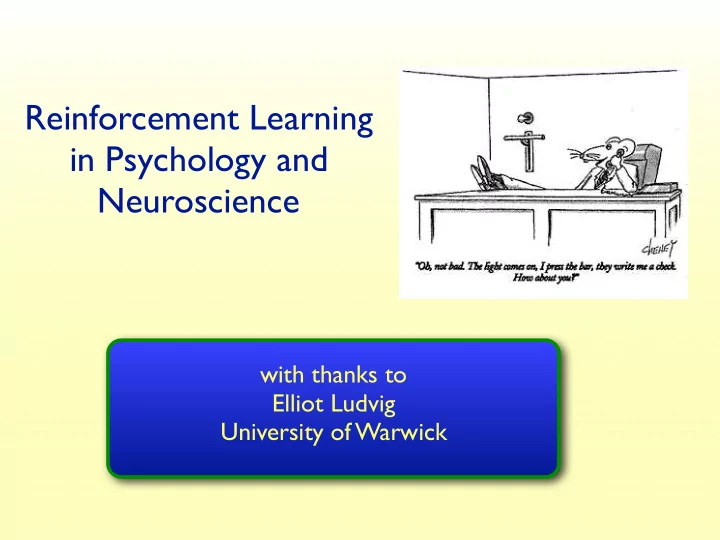

Reinforcement Learning in Psychology and Neuroscience with thanks to Elliot Ludvig University of Warwick
Bidirectional Influences Psychology Artificial Intelligence Reinforcement Learning Control Neuroscience Theory
Any information processing system can be understood at multiple “levels” • The Computational Theory Level – What is being computed? – Why are these the right things to compute? • Representation and Algorithm Level – How are these things computed? • Implementation Level – How is this implemented physically? David Marr, 1972
Goals for today’s lecture • To learn: • That psychology recognizes two fundamental learning processes, analogous to our prediction and control. • That all the ideas in this course are also important in completely different fields: psychology and neuroscience • That the details of the TD( λ ) algorithm match key features of biological learning
Psychology has identified two primitive kinds of learning • Classical Conditioning • Operant Conditioning (a.k.a. Instrumental learning) • Computational theory: ❖ Classical = Prediction - What is going to happen? ❖ Operant = Control - What to do to maximize reward?
Classical Conditioning
Classical Conditioning as Prediction Learning • Classical Conditioning is the process of learning to predict the world around you ❖ Classical Conditioning concerns (typically) the subset of these predictions to which there is a hard- wired response
Pavlov (1901) • Russian physiologist • Interested in how learning happened in the brain • Conditional and Unconditional Stimuli
Is it really predictions?
Maybe Contiguity? • Foundational principle of classical associationism (back to Aristotle) ❖ Contiguity = Co-occurrence ❖ Sufficient for association?
Contiguity Problems • Unnecessary: ❖ Conditioned Taste Aversion • Insufficient: ❖ Blocking ❖ Contingency Experiments
Blocking Phase 1 Phase 2 Light comes to Will sound come to cause salivation cause salivation? No. Learning about the sound in Phase 2 does not occur because it is blocked by the association formed in Phase 1
Rescorla-Wagner Model (1972) • Computational model of conditioning ❖ Widely cited and used • Learning as violation of expectations ❖ As in linear supervised learning (LMS, p2) ❖ TD learning is a real-time extension of this same idea
Operant Learning • The natural learning process directly analogous to reinforcement learning • Control! What response to make when?
Thorndike’s Puzzle Box (1910)
Law of Effect • “Of several responses made to the same situation, those which are accompanied by or closely followed by satisfaction to the animal will, other things being equal, be more firmly connected with the situation, so that, when it recurs, they will be more likely to recur...” - Thorndike (1911), p. 244
Operant Chambers
Complex Cognition
Any information processing system can be understood at multiple “levels” • The Computational Theory Level – What is being computed? – Why are these the right things to compute? • Representation and Algorithm Level – How are these things computed? • Implementation Level – How is this implemented physically? David Marr, 1972
The Basic TD Model • Learn to predict discounted sum of upcoming reward through TD with linear function approximation • The TD error is calculated as: δ t . = R t +1 + γ ˆ v ( S t +1 , θ ) − ˆ v ( S t , θ )
TD( λ ) algorithm/model/neuron Reward ∑ w i ⋅ x i States x i e i w i δ i or TD Features Value of state Error or action λ w i ~ δ ⋅ e i ˙ TD Eligibility Error Trace
Brain reward systems What signal does this neuron carry? Honeybee Brain VUM Neuron Hammer, Menzel
Dopamine • Small-molecule Neurotransmitter ❖ Diffuse projections from mid-brain throughout the brain Key Idea: dopamine responding = TD error
What does Dopamine Do? • Hedonic Impact • Motivation • Motor Activity • Attention • Novelty • Learning
TD Error = Dopamine Error Calculation Current Old + New Schultz et al., (1997); Dopamine Montague et al. (1996)
Dopamine neurons signal the error/change in prediction of reward Wolfram Schultz, et al.
Reward Unexpected Reward Value TD error Reward Expected Cue Value TD error Reward Absent Value TD error δ t = R t +1 + γ ˆ v t +1 − ˆ v t
The theory that Dopamine = TD error is the most important interaction ever between AI and neuroscience
Goals for today’s lecture • To learn: • That psychology recognizes two fundamental learning processes, analogous to our prediction and control. • That all the ideas in this course are also important in completely different fields: psychology and neuroscience • That the details of the TD( λ ) algorithm match key features of biological learning
What have you learned about in this course (without buzzwords)? • “Decision-making over time to achieve a long-term goal” – includes learning and planning – makes plain why value functions are so important – makes plain why so many fields care about these algorithms • AI • Control theory • Psychology and Neuroscience • Operations Research • Economics – all involve decision, goals, and time... • the essence of... mind? intelligence? Intelligent Systems.
Bidirectional Influences Psychology Artificial Intelligence Reinforcement Learning Control Neuroscience Theory
Recommend
More recommend